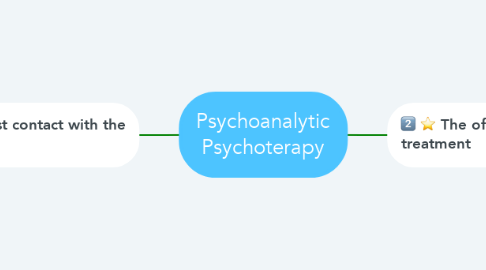
1. The office and the setting of treatment
1.1. The therapist must have an office and a telephone
1.2. The layout and decoration of the therapist's surroundings inevitably reflect his/her personality
1.2.1. Furniture arrangements: with or without a desk
1.3. A therapist's office can be located in a professional building
1.3.1. Should be comfortably furnished and efficiently sound-proofed
1.4. It is not suggested that the therapist office is located at his/her home, because it may stimulate fantasies and desires that become an obstacle for the therapy
1.5. Logistics of the telephone
1.5.1. Must have a designated and private telephone
1.5.2. Been available to attend emergencies
1.5.3. Not able to pick up calls during therapy sessions
1.5.4. There must a protocol in place to attend emergencies
1.6. Confidentiality
1.6.1. Discretion and silence must prevail
1.6.2. There should be no third party to the therapeutic relationship, with the sole exception of a supervisor
1.6.3. Should never discuss patients with friends or family
1.6.4. Violations are not only destructive to the patient, they also give a poor reputation to the psychotherapy field
2. The first contact with the patient
2.1. The first telephone call in private practice
2.1.1. The therapist's basic stance
2.1.1.1. Understand that the initial telephone call reveals important aspects of the patient's anticipatory attitudes towards therapy and the therapist
2.1.1.2. Listen to these calls with an ear for diagnosis, dynical conflicts, and in particular, be alert of signs of strong resistance
2.1.1.3. Respond to questions with these resistances, and reality in mind
2.1.2. Consultation or immediate referral
2.1.2.1. Show concern and be of assistance
2.1.2.2. If only consultation is possible, inform the patient of this and explain what you can offer him through it
2.1.2.3. If you decide on direct referral to a therapist with available time, refer the patient to someone that you know has open time or make the calls yourself so that he will be more likely to follow through
2.1.2.4. In regard to every aspect of the initial phone call, be a therapist and be therapeutic: treatment has already begun
2.1.3. Some common problems
2.1.3.1. Be alert to indications of severe depression and manifest or implied (concealed) suicidal thoughts and impulses as they are revealed or hinted at in the first phone call
2.1.3.2. Take them seriously as emergencies, and arrange to see the patient that day - and ASAP
2.1.3.3. To whatever extent it is possible, accept the patient initially on his own terms
2.1.3.4. If someone else makes the first call and the patient is not available, make the first appointment with him
2.1.3.5. Learn what you can directly and implicitly from such a call, and be prepared to deal with the resistances and problems it reflects in the first hour
2.1.4. Who the therapist should not treat
2.1.4.1. Close and distant relatives of the therapists cannot obtain unbiased and uncontaminated therapy, and should be referred to a colleague
2.1.4.2. The same is true of close and even distant friends
2.1.4.3. Do not treat anyone like whom there has been a prior relationship, either between yourself or between a close relative of your and the prospective patient
2.1.5. Referrals from the therapist's patients
2.1.5.1. Analyze the conscious and unconscious meanings of the referral for the patient who has made it
2.1.5.2. Refuse the referral at an appropriate point in the session after it has been explored
2.1.5.3. Consider and analyze the underlying dynamics, defenses, and fantasies for the patient-and for yourself
2.1.5.4. Assess the real implication for the present and anticipated treatment
2.1.6. Initial contacts with patients in clinics
2.1.6.1. Many clinics leave the arrangements for initial interviews to secretaries of social workers to screen patients and collect data
2.1.6.2. If there is any level of past or present personal contact between a potential patient and a given therapist, the patient should not be seen by that therapist
